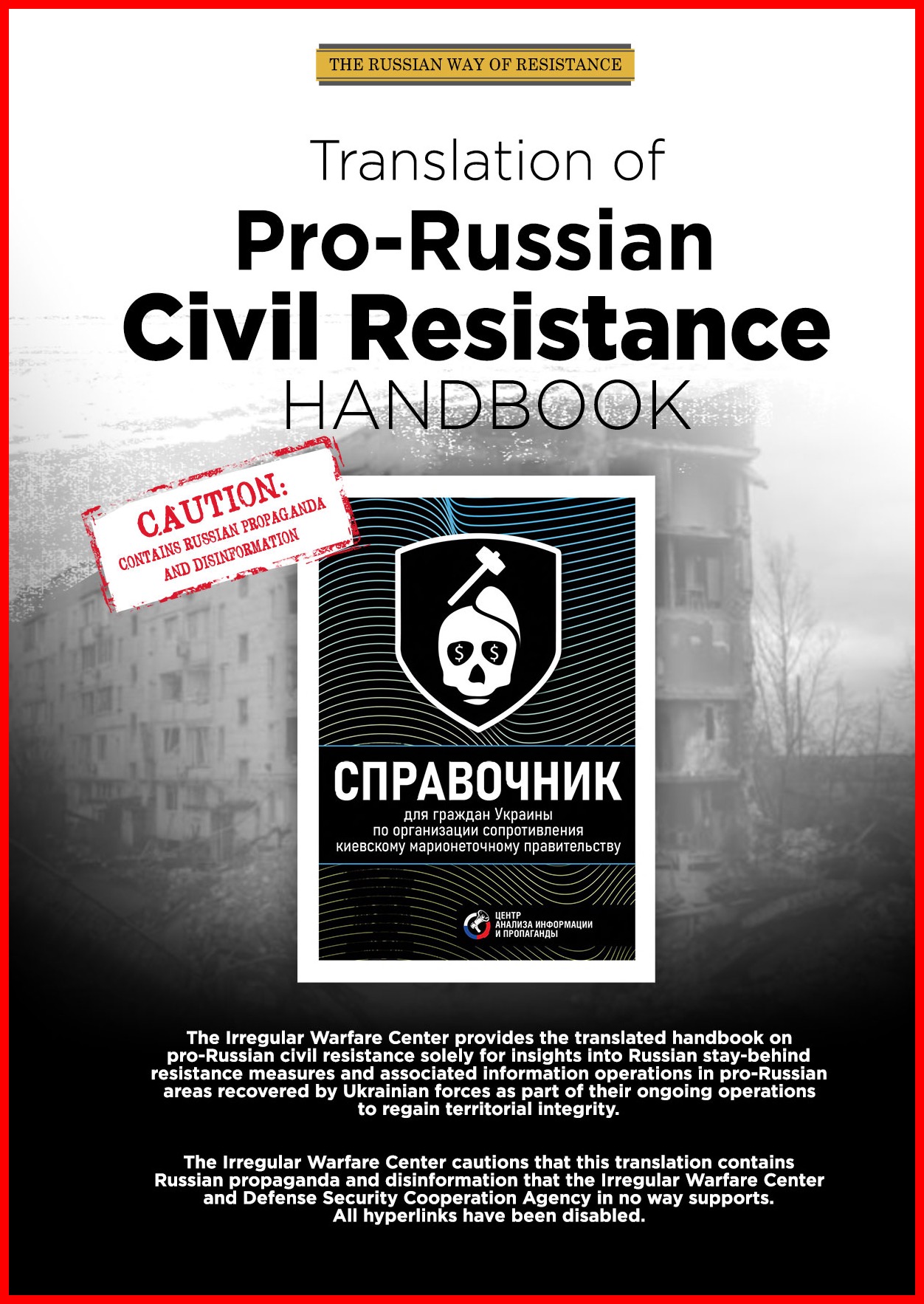
Simple Sabotage 2.0: the Threat of Pro-Russian Civil Resistance in Ukraine
Sandor Fabian PH.D. – IWC Chair, Engagements
Kevin Stringer PH.D. – IWC Chair, Education
Andrew Liflyandchick – IWC Analyst
Resistance is an asymmetric tool that can be used by an underdog to fight against an oppressor or a foreign military occupation. However, the Russo-Ukrainian War has demonstrated that this concept can also be used by an occupying force. As part of the Irregular Warfare Center’s (hereafter, IWC) ongoing mission to illuminate and address irregular threats posed to the U.S. and its allies and partners, the Center recently obtained and translated a Russian handbook designed to instruct pro-Russian Ukrainian citizens on how to resist the Ukrainian government; something that is especially relevant in recently recaptured territories. As a primer prior to the publication of the actual translation of the Pro-Russian Civil Resistance Handbook, this article provides context for and a short analysis of the document. It also highlights the surprising connection the handbook shares with sabotage tactics used by U.S. intelligence during WWII.

After Russia invaded and illegally annexed Crimea in 2014, many Eastern-European countries were forced to revise their approaches to national defense. In response to these changes, several countries developed and implemented the Total Defense Strategy, a defense concept that relies on the combination of both conventional defense and resistance in occupied territories. The latter places responsibility on each individual citizen to resist an occupier through either violent or non-violent means. Russia’s unilateral invasion of Ukraine in 2022 put this concept to the test, and, as a result, has proven that total defense is an indispensable tool for weaker countries preparing resilience and resistance capabilities against a much stronger foe.
The Russian resistance handbook translated by the IWC provides valuable insights into what tactics, techniques, and procedures Russians might use to foment resistance in Ukraine-held territories. Understanding these efforts is vital for not only Ukraine but also for other countries in the region facing potential Russian aggression. Georgia, Moldova, Latvia, and Estonia might be particularly vulnerable to similar campaigns. Acknowledging the existence of pro-Russian resistance tactics, techniques, and procedures and examining their characteristics is critical for building societal resilience and developing effective countermeasures against similar Russian activities.
On 11 November 2022, Ukrainian troops entered the city of Kherson. This ended an eight-month-long Russian occupation marked by brutality, fear, and repression. While many Ukrainians rushed to the streets to greet the troops whom they saw as their liberators, others were not as supportive. For residents who had supported the Russian invasion, actively collaborated with occupation forces, and/or bought into the constant waves of Russian propaganda, the return of Kherson to Ukrainian control came with risks to personal safety. Perceived collaborators faced the possibility of vigilante attacks from their fellow citizens or investigations and detention by Ukrainian intelligence.
Devising a strategy for reintegrating citizens who may still hold pro-Russian sentiments is one of the primary challenges in the process of rebuilding the formerly occupied territories. Ukraine already possesses an administrative vehicle that can assist in the coordination of such efforts in its Ministry for the Reintegration of the Temporarily Occupied Territories. However, recovery from the social divides caused by the occupation will require the establishment of clear legal definitions of what constitutes collaboration and with what severity and strictness it should be punished. Loose definitions leading to overzealous and inconsistent prosecution could lead to resentment and create opportunities for Russian influence operations to stir civil resistance.
The Russian civil resistance handbook is designed to provide guidance, detailed information, and inspiration for pro-Russian Ukrainian citizens. The document is organized into a propaganda section and 14 thematical, pamphlet-like sections mostly organized around occupational specialties that are deemed to be the most effective in hampering Ukrainian government efforts. These occupations range from government employees to medical professionals to even religious figures such as priests. The handbook’s suggestions focus on low risk “simple sabotage” actions that any member of society can participate in without the need for organization and coordination. As the handbook notes, “every single one of you can provide an effective resistance to the American puppets and bring us closer to the end of the special military operation.”
Central to the messaging contained in the propaganda section of the handbook is the idea that potential saboteurs are part of something larger than themselves—that they are part of a movement of like-minded people, even if they might never come into contact. This idea is pursued in the handbook from the very first line by addressing Ukrainian citizens as “our dear brothers and sisters” and by emphasizing that “the greatest treasure for Russia is her wonderful multi-national people.” These are phrases designed to elicit instant recognition among population groups previously exposed to Russian government messaging, and directly echo the July 2021 article written by Russian President Vladimir Putin, titled “On the Historical Unity of Russians and Ukrainians.” In this article, which has since then been used by Russian sources as a justification for the invasion of Ukraine, President Putin argues that Russians and Ukrainians have always been a unified people and that the illegitimate Ukrainian government, controlled by the West, is seeking to divide them. This logic also forms the basis for Russian efforts to frame the invasion of Ukraine as a liberation—something that Russian sympathizers are, in the handbook, encouraged to support through sabotaging their workplace.
As the Russo-Ukraine War goes on, the lack of innovation in Russia when it comes to modern military and strategic thought has become increasingly apparent. Russian military leadership is increasingly relying on WWII and Cold War experiences as a basis for planning, with little success. While many of these strategies are being taken from the Soviet playbook, this resistance handbook shows that past strategies from other countries, including the U.S., its allies, and partners, can also be considered fair game.
In 1944, the Office of Strategic Services (OSS), the precursor to the Central Intelligence Agency, began the covert distribution of a manual titled the “Simple Sabotage Field Manual.” This manual, which was declassified and made public in 2008, had the purpose of serving as a guide for “citizen-saboteurs” living in territories occupied by the Axis powers and that might be sympathetic to U.S. goals. The manual gives instructions on how to sabotage enemy industrial, military, and government functions and, by extension, how to create “a constant and tangible drag on the war effort of the enemy.” The OSS believed that when done on a large scale, simple sabotage has a noticeable impact on enemy war capabilities and morale.Over 75 years later, the tactics contained in the OSS manual are once again being distributed during an ongoing war. This time, however, the source is a Russian civil resistance handbook, and the new target audience is pro-Russia sympathizers in Ukraine.
While many of the tactics encountered within the Russian handbook are directly borrowed from the OSS manual, the approach the Russian authors have taken to distribution is different in a way that better reflects the modern environment. The director of the OSS during WWII, William “Wild Bill” Donovan, held the view that the Simple Sabotage Field Manual should only be distributed selectively and with great caution. Only small parts of it could be used in pamphlets and radio broadcasts, and even then, only at the discretion of the theatre commander.
The Russian authors take a different track. Their handbook takes advantage of the power that social media platforms such as Telegram provide to disseminate the instructions and propaganda in the handbook to the widest possible audience. According to the OSS manual, simple sabotage is a method that relies on large numbers of voluntary saboteurs to achieve its objectives. With social media serving as a force multiplier, previously limited simple sabotage campaigns have the potential to be a much more effective and powerful strategy than before.
However, an important caveat to note is that because the origin of the handbook is a newly created social media account made expressly for the purpose of anonymous distribution, the degree of its connection to the Russian (or any other) government cannot be established. While many pro-Kremlin propagandists, bloggers, and social media influencers work directly or indirectly with the Russian state, others might create and disseminate material on their own initiative. Yet, these unclear origins did not prevent the handbook from being picked up and reposted by major Russian war bloggers with connections to Kremlin propaganda networks, such as Boris Rozhin, who has over 800,000 subscribers on Telegram. This gave the handbook a significantly higher visibility and reach than would have been possible unaided while allowing the original authors to maintain plausible deniability. In July 2022, the handbook was also highlighted by Ukraine’s Ministry of Defense as an example of “Kremlin propaganda.”
In conclusion, regaining control over its sovereign territory from the occupier might not mean the end of hostilities for Ukraine. Pro-Russian sentiments among members of society, combined with effective Russian information operations, can create favorable conditions for Russian-supported civil resistance to occur. The Pro-Russian Civil Resistance Handbook serves as both a propaganda product and a tactical manual for pro-Russian sympathizers in Ukraine on how to resist the Ukrainian government’s reintegration efforts. Understanding the Russian tactics, techniques, and procedures described in this translated document can help practitioners and policy makers to accurately assess and mitigate this potential threat. It is especially relevant to countries that have historically been the target of Russian influence and information operations, including those with significant ethnic Russian minorities, such as Estonia and Latvia, and those currently facing a partial Russian occupation, such as Georgia and Moldova.
The IWC will continue its efforts to illuminate similar documents and make their translations available to interested parties. The translation of the Pro-Russian Civil Resistance Handbook, along with additional notes on origins and context, will soon be available to researchers and practitioners on request through the IWC’s website.
